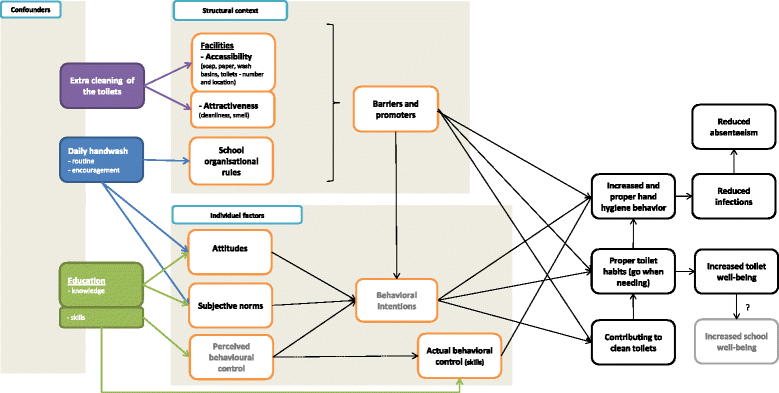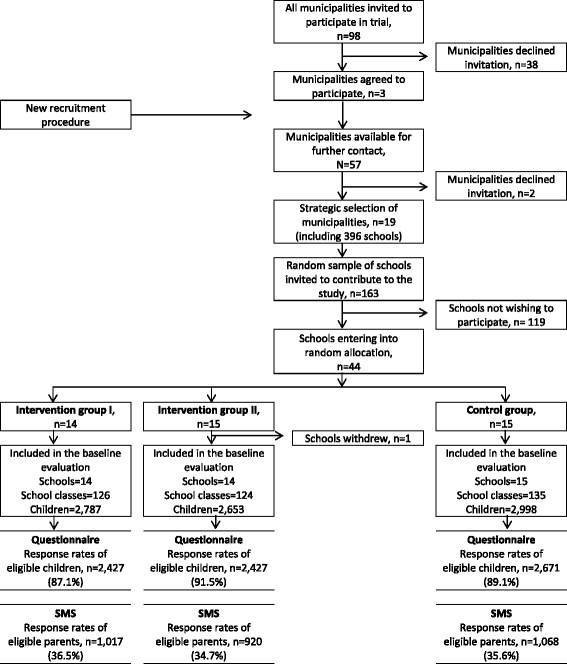The Hi Five study: design of a school-based randomized trial to reduce infections and improve hygiene and well-being among 6-15 year olds in Denmark
- PMID: 25886286
- PMCID: PMC4351932
- DOI: 10.1186/s12889-015-1556-1
The Hi Five study: design of a school-based randomized trial to reduce infections and improve hygiene and well-being among 6-15 year olds in Denmark
Abstract
Background: Infectious illnesses such as influenza and diarrhea are leading causes of absenteeism among Danish school children. Interventions in school settings addressing hand hygiene have shown to reduce the number of infectious illnesses. However, most of these studies include small populations and almost none of them are conducted as randomized controlled trials. The overall aim of the Hi Five study was to develop, implement and evaluate a multi-component school-based intervention to improve hand hygiene and well-being and to reduce the prevalence of infections among school children in intervention schools by 20% compared to control schools. This paper describes the development and the evaluation design of Hi Five.
Methods/design: The Hi Five study was designed as a tree-armed cluster-randomized controlled trial. A national random sample of schools (n = 44) was randomized to one of two intervention groups (n = 29) or to a control group with no intervention (n = 15). A total of 8,438 six to fifteen-year-old school children were enrolled in the study. The Hi Five intervention consisted of three components: 1) a curriculum component 2) mandatory daily hand washing before lunch 3) extra cleaning of school toilets during the school day. Baseline data was collected from December 2011 to April 2012. The intervention period was August 2012 to June 2013. The follow-up data was collected from December 2012 to April 2013.
Discussion: The Hi Five study fills a gap in international research. This large randomized multi-component school-based hand hygiene intervention is the first to include education on healthy and appropriate toilet behavior as part of the curriculum. No previous studies have involved supplementary cleaning at the school toilets as an intervention component. The study will have the added value of providing new knowledge about usability of short message service (SMS, text message) for collecting data on infectious illness and absenteeism in large study populations.
Trial registration: Current Controlled Trials ISRCTN19287682 , 21 December 2012.
Figures
References
-
- Nielsen A, Koefoed B, Møller R, Laursen B. [Prevalence rates of recent illnesses in Danish children, 1994 and 2000] UgeskrLaeger. 2006;168(4):373–8. - PubMed
-
- Nandrup-Bus I. What are the reasons for elementary school absenteeism? How often do pupils wash their hands during school hours? Dan J Nurs. 2008;108:50–7.
-
- Lund J, Hune LJ. Absenteeism among children in public elementary school 2010/2011 [Elevfravær i folkeskolen 2010/2011] Copenhagen: The National Agency for It and Learning; 2012.
-
- Bloom B, Cohen R, Freeman G. Summary Health Statistics for U.S. Children: National Health Interview Survey, 2011. National Center for Health Statistics. Vital Health Stat. 2012;10(254):1–88. - PubMed
Publication types
MeSH terms
LinkOut - more resources
Full Text Sources
Other Literature Sources
Medical
Miscellaneous



